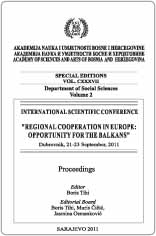The Vienna Convention on International Sale of Goods: a Tool for Unification of Regional Regulations for Trade in Goods in Europe?
The Vienna Convention on International Sale of Goods: a Tool for Unification of Regional Regulations for Trade in Goods in Europe?
Author(s): Miloš TrifkovićSubject(s): Economy
Published by: Akademija Nauka i Umjetnosti Bosne i Hercegovine
Keywords: CISG; EU; CEFTA 2006; BH; unification
Summary/Abstract: Research shows that the impact of the Convention on International Sale of Goods (CISG) on national legislators and legal practitioners in international trade of goods is not as significant as CISG’s acceptance on global and European level. Overcoming that difficulty in the area of commercial sales is the central subject of this paper. Comparison of CISG with sale laws in EU, CEFTA 2006 and BH reveals that the CISG vertically influences these systems in two basic ways. The model of direct impact means solely the adoption of the Convention into national law as the source for international sales. Reception of CISG’s norms into national general sale and contract law is the main feature of the second, indirect model. So far, the direct model of CISG’s influence absolutely dominates in legal systems participating in European regional integrations. That dominance doesn’t translate into CISG-driven unification of national domestic sale legislation and contract law in general. Thus, state legislators have room to create new, different solutions for substantially identical sale transactions at home and abroad. In order to avoid the crumbling of historically achieved horizontal unification level among national sale and contract laws, the implementation of the CISG indirect model is a necessity. Consequently, the CISG can really be a tool for unification of regional regulations of trade in goods in Europe only if the direct and indirect models are applied jointly and successfully. EU practice offers a useful pioneering experience for this process.
Journal: Posebna izdanja Akademije nauka i umjetnosti BiH
- Issue Year: 2011
- Issue No: 2
- Page Range: 81-103
- Page Count: 23
- Language: English

